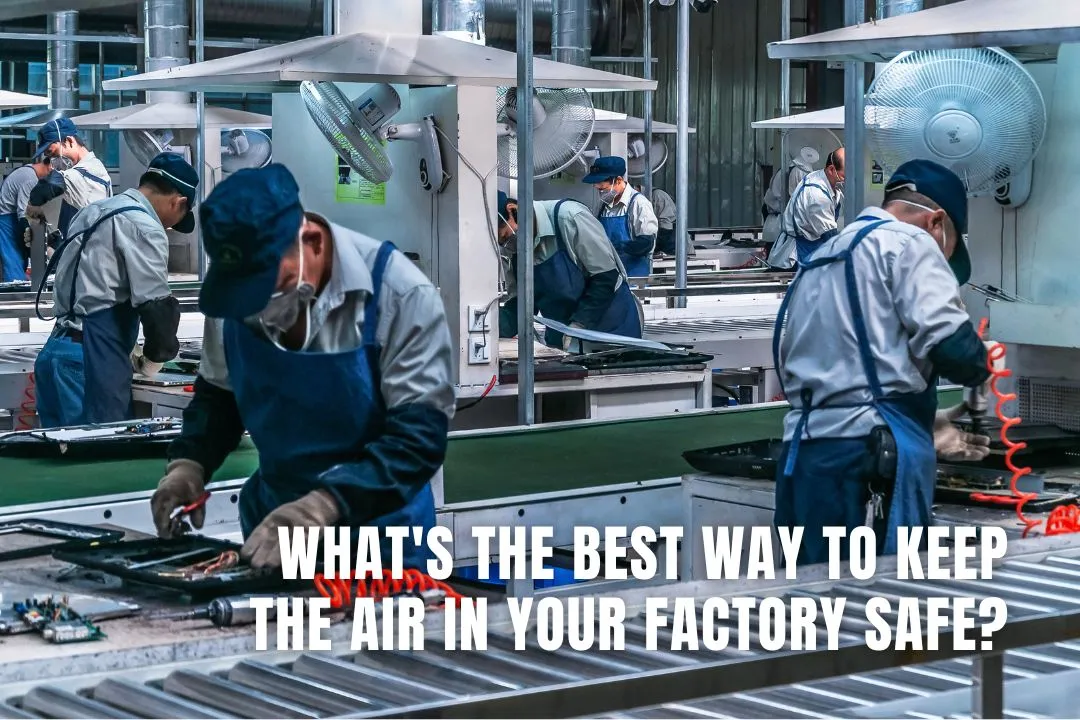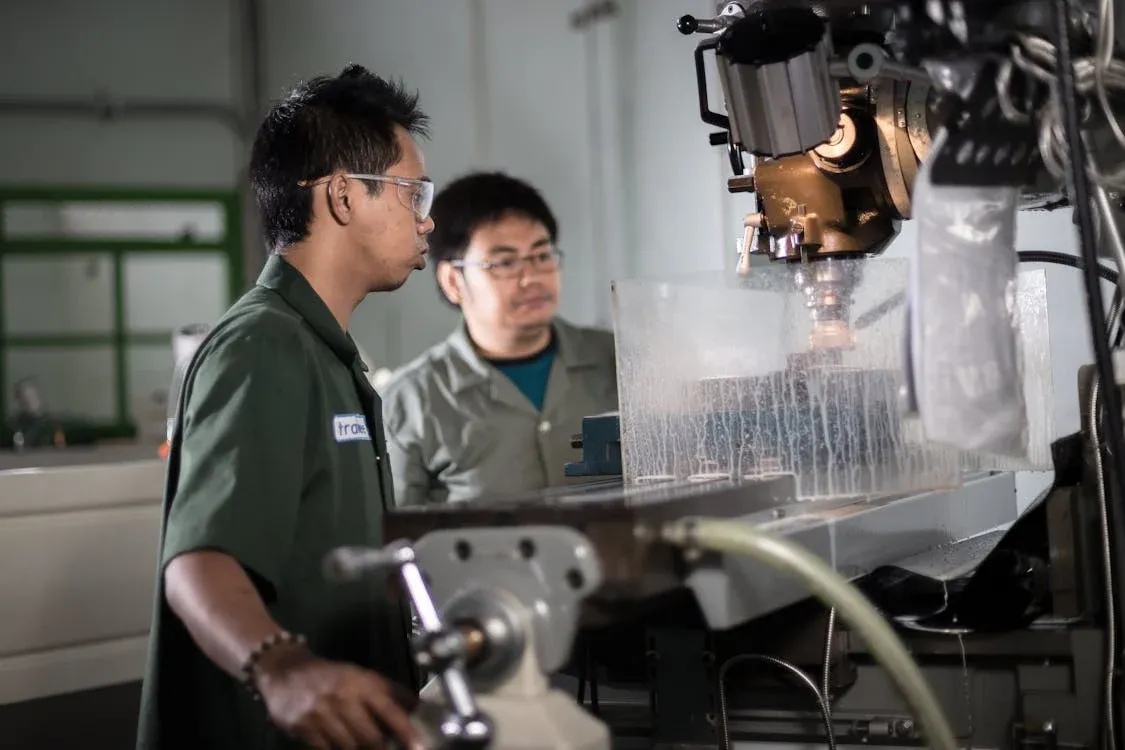What's The Best Way To Keep The Air In Your Factory Safe?
February 5, 2025

Industrial businesses think a lot about keeping their people and water safe. But when it comes to the air, that’s not always something they think about upfront.
Yes, they know it’s important. But they don’t always have systems in place to monitor and evaluate it.
That’s where this post can help. It’s a sort of guide for companies that run factories, explaining how to keep the air relatively pollution-free and safe for workers, no matter what you’re making.
Naturally, the types of toxins that get into the atmosphere will differ, depending on the kind of work you do. But if you can understand different approaches and the basics, you’re often in a much better position than the vast majority of companies operating under similar conditions.
Key Takeaways on Keeping the Air in Your Factory Safe
- Install High-Efficiency Air Filtration: Using HEPA filters can significantly improve air quality by removing particulate matter, making the work environment safer.
- Stay Compliant With Air Quality Regulations: Ensure your business adheres to air quality regulations, which may help you avoid audits or health complaints in the future.
- Use Dust Extraction Systems: Implement dust extraction systems to keep particles out of the air and reduce health risks caused by high dust levels or sharp dust particles.
- Regular Air Quality Checks are Crucial: Schedule regular checks to monitor air quality, identify trends, and take corrective actions when necessary.
- Maintain a Robust Cleaning Schedule: A good cleaning schedule reduces settled particles and helps prevent mold buildup, which can affect air quality.
- Maintain Equipment to Prevent Air Pollution: Proper equipment maintenance can reduce dust, chemical vapours, and exhaust emissions, keeping air quality in check.
- Ensure Personal Protective Equipment (PPE) Availability: When air quality can’t be fully controlled, respirators and PPE are necessary to protect workers from inhaling harmful pollutants.
Register Your LLC
Company Registration
START NOWInstall High-Efficiency Air Filtration
Start by installing high-efficiency air filtration using HEPA filters. These help to keep the circulating air relatively clean and free from pollutants.
No, it won’t be perfect. But you should find that you can remove most of the particulate matter with relative ease.
If you’re worried, you can now get air particulate monitoring devices. These tell you the levels of particulate matter in the air at any given time.
You can also get systems that monitor gases and other elements, like Drager Tubes. These are handy whenever you’re watching out for anything invisible, integrated with the air, or non-particulate.
Remain Compliant With Air Quality Regulations
As you’re assessing your workplace for air quality, you also want to double-check your remaining compliant with air quality regulations. Keeping an eye on these is handy, just in case you come up against an audit or a worker complains.
Air quality regulations differ by country, but you can usually find these fairly easily online. Then, you can use your monitoring systems to determine whether you’re within acceptable limits or if you need to take action.
Don’t be surprised if your air quality is lower than you expect. While you might not be able to smell or see anything, that doesn’t mean your processes are clean. Outgassing is much more of a problem than many executives realise, and it can seriously harm health if left unchecked.
Use Dust Extraction Systems

You also want to ensure you’re using dust extraction systems. These remove particles from the air, allowing people inside to work in a cleaner atmosphere.
Dust isn’t always made of dangerous substances, and a lot of it is natural. However, it can cause irritation if quantities rise too high.
Furthermore, some types of dust can be sharp. If these make contact with the airways, they can cause damage to the delicate lining, leading to breathing difficulties (a serious occupational hazard).
Dust extraction systems are fairly straightforward to install and maintain. You will need to consult with experts, but once you have the parts in place, that’s usually all you have to do.
Perform Regular Air Quality Checks
We’ve already discussed the value of monitoring, but you should put air quality checks on a regular schedule. Most firms track air quality every week (in high-risk industries) and every month otherwise.
When you have readings, chart them. A healthy system will wobble around a predictable mean of impurities. However, if you see an upward (or downward) trend, it could indicate an issue.
Stay On Top Of Your Cleaning
You also want to stay on top of your cleaning schedule. Getting to grips with this can reduce the number of particles in the air and keep your premises relatively dust-free.
Again, getting this right requires the right cleaning schedule. The more you can remove settled particles on floors and machinery, the less of it will get into the air that your people have to breathe.
Pay special attention to damp, clearing up any spills as soon as you can. These often lead to mold, which some people can react to strongly.
Staying on top of your cleaning is more straightforward than you think if you outsource it. Getting another company to take care of it is a high-impact and sensible move that can reduce admin.
Maintain Your Equipment
You can also boost air quality by simply maintaining your equipment. The happier it is as it buzzes along, the better off you’ll be.
Equipment maintenance can deal with all sorts of issues that might adversely impact air quality, including reducing the buildup of:
- Dust
- Chemical vapors
- Exhaust emissions
The more care that takes place, the better. Some machines will function normally for years, but they can deteriorate quickly. That’s why it’s critical to swap out high-wear parts according to manufacturer instructions (and sometimes more frequently). If you don’t have the skills to do this in-house, call in professionals to do it for you. Most machine manufacturers will have dedicated teams in your region who can provide support when you need it.
Use Low-Emission Processes
Another way to keep the air in your industrial factory clean is to use low-emissions technology. These systems reduce the overall air quality risk by simply lowering the load in your environment.
Naturally, diesel engines will always be problematic. But these days, manufacturers are getting better at applying coatings and lubricants that reduce risk while maintaining a similar level of performance.
Provide Personal Protective Equipment
Sometimes, it isn’t possible to remove the pollutants from the air inside your factory. When this happens, use personal protective equipment (PPE). These devices can reduce the vast majority of toxic fumes, particles, and even viruses going into the lungs.
Personal protective equipment usually takes the form of respirators. These aren’t the same as masks because they create a seal around the face, purifying the air as workers breathe it in.
Respirators are almost always essential when dealing with paints and other volatile chemicals. However, they can also come in handy in other situations, including when managing oils, lubricants, fats, and petroleum derivatives.
Train Employees
Training employees on the value of air quality is another way to get leverage over the problem. The more you can provide them with the knowledge and skills they need, the better.
Training employees in air safety protocols could include things like:
- Talking to workers about the value of ventilation (and how they should avoid working in enclosed spaces)
- Providing instructions on hazardous material handling, especially items that can turn to gas when exposed to room temperatures and pressures
- What to do in the event of an emergency, including inhaling toxic gases by accident
Once you have training in place, it becomes easy to make safe air a priority at your organization. People understand its value and what they need to do to achieve it.
Add Ventilation
Lastly, and perhaps most importantly, add ventilation to your factory. You want to ensure you are exchanging the air regularly to keep it pure.
Opening a window can work. But ideally, you want something with positive pressure that can force air in and out, especially in parts of your facility most prone to contaminant buildup.
Ventilation requires proper designs, including air exchangers, exhaust fans, and vents (usually high on the walls or in the roof).
It also requires systems that keep the air circulating and prevent anything nasty from building up.
Conclusions
So, what have we learned?
It turns out that there are many ways to keep the air in your factory relatively pure and clean. Most of the time, you won’t need to implement all the measures highlighted above. But putting some of them in place can be helpful for any company wanting to protect its people and enhance its processes.

